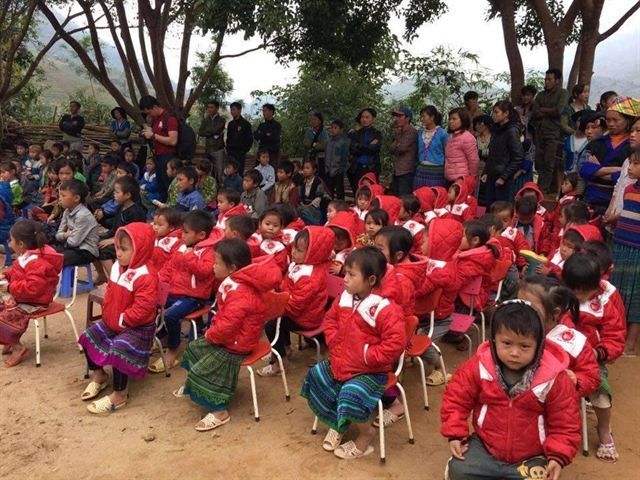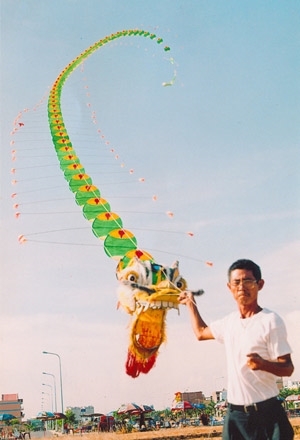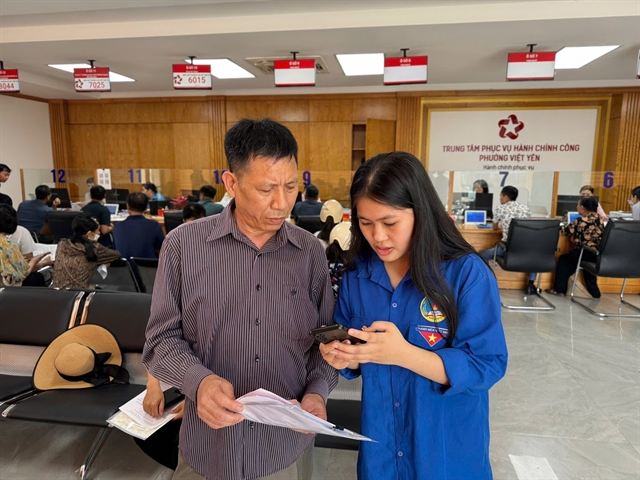 Features
Features

Kite maker Nguyễn Thanh Vân, of HCM City’s District 8, is known as the father of the longest kite in Việt Nam - a dragon-shaped kite trailing 100 metres.
 |
| Record setter: Vân at the 2006 Festival of the Sea in Ba Ria-Vung Tau Province, where his dragon-shaped kite measuring 100 metres from tip to tail set a national record. File photo |
by By Bích Hường
Kite maker Nguyễn Thanh Vân, of HCM City’s District 8, is known as the father of the longest kite in Việt Nam - a dragon-shaped kite trailing 100 metres.
The 65-year-old man is also the first kite maker in the country to be granted the title “folk artisan”.
His kites have joined hundreds of domestic and international kite festivals, showcasing not only the maker’s talent, but also the image of a peaceful Việt Nam.
At the 28th International Kite Festival held in India earlier this year, Vân told locals, “Our reason for flying kites is similar to that of Indians; we fly kites in the rice fields during the harvest season.”
He said he started making kites when he was six years old, and the enthusiasm he felt for the craft has endured 60 years.
In 1999, he founded the Phượng Hoàng (Phoenix) Kite Club - the first of its kind in southern Việt Nam - where kite lovers including school children come to share their common passion for making and flying kites.
Lifelong passion
In his early days, he said, flying kites was an activity for young men. He attempted to make his first kite when he was about five years old after losing a kite that someone had lent him. His brother delayed making another kite for him, so angered by the lack of fraternal co-operation, Vân whittled some bamboo into a frame and cut out some paper to cover it in hopes of making a kite himself.
But all he had to show for this effort were some wounds after cutting himself, for which his parents punished him. However, he kept trying and started to unravel the mysteries of kite-making.
Later on, he became an electrician, but still found time to make better and better kites. With no space left for kite flying in the crowded city, Vân travelled hither and thither seeking the ideal field, and eventually found that paddy fields on the city outskirts were ideal for his purpose.
When he was 10, he was able to make a phoenix-shaped kite. He treasured the kite so much that he set it beside him while sleeping.
“I prefer making kites rather than flying them,” he said. “I could spend hours designing patterns, cutting cloth, whittling bamboo and colouring the kite without caring for anything else around me.”
“It’s a feeling that is difficult for me to describe when I finish a kite,” he said, adding that it was a kind of childlike happiness and eagerness, because he just wanted to touch and look at the finished works all the time.
People always show their respect towards him, as well as their surprise at his creativity and talent.
On his kites, Vân draws his hometown’s beautiful landscapes or tourist attractions like Bến Thành Market, Nhà Rồng Wharf and the One-Pillar Pagoda.
He has made kites featuring the national flag, as well as kites in the shape of dragons, phoenixes, fish, birds or flowers.
At the 2006 Festival of the Sea in Bà Rịa-Vũng Tàu Province, his dragon-shaped kite measuring 100 metres from tip to tail set a national record. The kite was flying high as the crowd applauded and watched in awe, but few knew that it took Vân and his partners almost two years to make it.
The original kite was only 50 metres long, but weighed about seven kilos, which made it too heavy to go airborne.
They ran along the riverside in an attempt to make it fly, but whenever they stopped, the kite fell down.
The bamboo that was used to make the kite frame was then whittled thinner and thinner to reduce the kite’s weight.
After each adjustment, they tried to fly it again and again, Vân said, recalling moments when the kite crashed into ponds or became trapped in trees. The fliers struggled to rescue it and had to cut some tree branches.
“Once, we spent more than seven hours trying to retrieve the kite because its string became entangled in the trees,” Vân said. “After that, we were so tired that we didn’t want to eat anything.”
The completed dragon kite introduced at the Vũng Tàu Sea Festival weighs just 1.5kg after numerous changes and sweat from the maker and fliers.
Flute kites are among Vân’s most favourable kites. In Việt Nam, flute kites were once used to warn villagers about Chinese Qing Dynasty invaders 200 years ago. Bamboo - the key material for this kite - is delightful to the ears, too.
The traditional kite is made from bamboo and paper, weighing about 4kg. Now, super light materials are used to reduce the kite weight to just 1kg, Vân said.
Previously, the flute tied to a kite could only produce random sounds made by the wind, but now, they can be designed to sound like a bell, train horn or tunes produced by several musical instruments.
“The flute kites go with me to international kite festivals, including those in Malaysia, Indonesia, Thailand, Singapore and Poland, helping to introduce typical Vietnamese hobbies,” he said.
In addition to sounds, Vân’s kites were once equipped with lights.
At one “unforgettable” contest in Malaysia in 2002, kites had to be flown at night with lights attached so that audience members could see them lighting up the sky.
"I was awarded the top prize for a kite that had a large wingspan and colourful lights. The lights shone in turns, from left to right, up and down, and changed colours," Vân said.
“It was the first time I made a kite with lights,” he added. "I was so concentrated on the kite that I was not aware that on the loud speaker organisers were asking me to come to the stage to receive the award.”
Kites connect people
Vân said his family, particularly his wife, has provided great support for his hobby.
For the last 20 years, when he is busy making kites and joining kite contests or festivals across Việt Nam and overseas, his wife has always been with him.
"She was always complaining that she cooked for me and had to clean the mess I make whenever I want a new kite," Vân said. “However, she is still the person who supports me most."
"We fell in love with each other when we flew kites together during our childhood. And now, she is with me to bring Vietnamese kites to an international playground.”
The Phượng Hoàng Kite Club is considered Vân’s second family.
Vân said that more and more children and young people are joining the club. Those at primary school ages can join to learn how to make simple kites. Older ones can go with Vân, whom they call "grandfather", to suburban areas for kite flying.
He is also invited to local primary and secondary schools to teach students about kites.
"I’m happy to see the students make and fly kites high," he said.
He said that when travelling to other countries like Singapore or Malaysia, he found that children there had a lot of space for kite flying.
"It’s unfortunate to see that Vietnamese children don’t have space for running and flying kites, particularly those in crowded urban areas," he said.
"We adults go to spacey suburban areas or the sites of delayed construction projects for kite flying. The image of windy, spacious kite fields is rare today.
"I teach my grandchildren and other young people about kites, hoping that it helps nurture their passion for kites. It’s not only an outdoor activity for physical development, but also an artist’s sport that strengthens mental and physical flexibility."
At his house on HCM City’s Trần Đình Xu Street, kites and materials to make kites are seen almost everywhere - on the floor, on the wall, along steps - but the house owner also reserves a large room for kites only.
Over the last 60 years, Vân has made thousands of kites, but he refuses to sell them, despite many prospective buyers expressing their interest.
“I make kites for passion, not for sale,” he said. VNS
 |
| Multicoloured: Vân with his flute kite in India earlier this year. |




